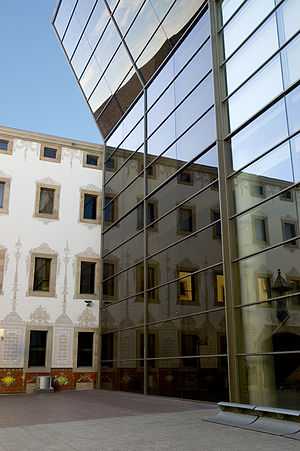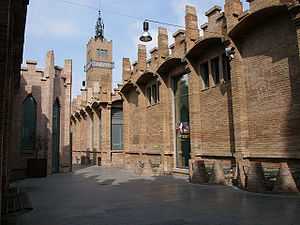Tourism in Spain
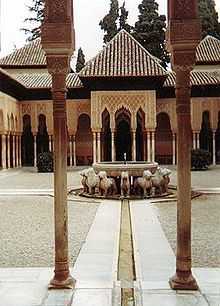
Tourism in Spain is a major contributor to the national economic life contributing with 6.4% of Spain's GDP. Ever since the 1960s and 1970s, the country has been a popular destination for winter holidays, especially with the tourists from the UK, Germany, France, Ireland, Scandinavia, Italy and the Benelux. Spain has held strong position in world's tourism, being among the largest markets for holidays.
In 2007, Spain became the second most visited country in the world after France. That year, almost 60 million foreign visitors came to visit Spain, according to the World Tourism Organization, which has its headquarters in Madrid. However, in 2010 Spain dropped to the fourth most visited country in the world after France, the United States and China with 53 million visitors.[1]
Spain's tourism industry contributed directly with 6.4% of GDP or around €62.1 billion ($81.8 billion) in 2010 according to the World Travel and Tourism Council,[2] the fifth largest income from tourism industry, based on 2010 World Travel and Tourism Council figures.[3] UNWTO measures tourism income differently,[4] and in its Tourism Highlights report, 2010 edition, places Spain ($53 billion) second only to US ($93.9 billion) in 2009 for "International Tourism Receipts". The UNWTO's own methodological notes explain the meaning of International Tourism Receipts and may help to explain the differences in the two organizations figures.

Transport
Spain's national airline is Iberia, but the country can also be flown into on many international passenger airlines such as Air Europa, Vueling, Air Berlin, Clickair and charter airlines, all of which fly to many tourist spots in the region.
Tourists also arrive in Spain by road, rail and over the water. Spanish freeways interconnecting the touristic cities are also linked up with the French freeway network across the Pyrenees. The main train operator is RENFE; the AVE (Spanish high speed train) or Talgo are the intercity services for tourists.
Summer resorts and beaches

This type of tourism was the first to be developed in Spain, and today, generates the most income for the Spanish economy. The mild climate during the whole year and the extensive sandy beaches of the Mediterranean and Atlantic Ocean as well as of its two archipelagoes (the Balearic Islands and the Canary Islands respectively) have been attracting tourists from Northern Europe for decades. The leading source markets of Spanish beach tourism are the UK (around 24% of the total arrivals in Spain in recent years), Germany and France (around 15-16% each), followed by Scandinavia and Italy (around 7% each) and the Netherlands (around 5%).[7][8]
The most popular Spanish coasts are on its Mediterranean side, and include, from north to south clockwise:
- The Costa Brava, the Costa Daurada and the Costa del Maresme, in the autonomous community of Catalonia, very popular with visitors from France as well as inland Spain, with notable resorts like Salou and the city of Barcelona.
- The Costa Blanca, (one of the most developed coastal areas of Spain, extremely popular for tourists from the United Kingdom and Germany, with Benidorm as the leading summer city of Spain) and the Costa del Azahar are both in the Valencian Community.
- The Costa Cálida in the Region of Murcia and the Mar Menor, a lagoon by the Mediterranean sea.
- The Costa de Almería, the Costa Tropical, the Costa del Sol and the Costa de la Luz, all in the community of Andalusia. Some of the summer destinations here are renowned worldwide, such as Marbella in Málaga Province or Sotogrande in Cádiz province, both destinations for tourists and summer residents with big purchasing power. The city of Málaga is a notable Costa del Sol destination and also one of the largest harbours in Spain and frequented by cruise ships.

Spain's two archipelagoes, the Balearic Islands off the mainland coast in the Mediterranean and the volcanic Canary Islands in the Atlantic, are also both very popular destinations with Spaniards and Europeans.
In addition to the summer tourism, other modalities like cultural and monumental tourism congresses, sport or fun tourism have been developed in these areas, including such famous cities as Barcelona and Valencia, the biggest harbours of the Spanish Mediterranean coast.
Many coastal or island places also have great ecological and natural importance. Theme Parks like PortAventura, Terra Mítica or diverse water-fun parks are also popular.
In 2014 Spain broke its own record of blue flag beaches, achieving 681 flags and becoming the leader in the Northern hemisphere.[9] Spain is also the leader in blue flags for marinas.[9]
Cultural tourism, business tourism

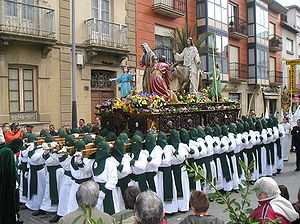
As a crossroads of several civilizations, Spain offers a number of historical cities and towns. Major destinations include Spain's two largest cities: Madrid and Barcelona, which stand as two of the leading city destinations in Europe. Both offer a matchless number of attractions and their importance in commerce, education, entertainment, media, fashion, science, sports and arts contribute to their status as two of the world's major global cities. Thirteen Spanish cities have been declared World Heritage Cities by the UNESCO:[10] Alcalá de Henares, Ávila, Cáceres, Córdoba, Cuenca, Ibiza, Mérida, Salamanca, San Cristóbal de La Laguna, Santiago de Compostela, Segovia, Tarragona and Toledo. As of June 2013, Spain has 44 total sites inscribed on the list, third only to China (45) and Italy (49). Of these 44 sites, 39 are cultural, 3 are natural, and 2 are mixed (meeting both cultural and natural criteria), as determined by the organization's selection criteria.[11] Other first-class destinations are Seville, Granada, Santander, Oviedo, Gijón, Bilbao and San Sebastián. All of them with historical landmarks and a lively cultural agenda.
Religion
Spain is an important place for Catholicism. In fact, some of the holiest places for the Catholic Church are in Spain: city of Santiago de Compostela in Galicia (North-West Spain), the third holiest place after the Vatican City in Rome and Jerusalem. It is also the terminus of the Way of Saint James. Santo Toribio de Liébana, Cantabria (also in North Spain) is the fourth, followed by Caravaca de la Cruz at the South-East, Region of Murcia (fifth holiest place). These places attract pilgrims and tourists from all over the world. Religion also has found its artistic expression through the popular Holy Week processions, which become important in almost every town.
Festivals

Most festivals turn around patron saints, legends, local customs and folklore. Among the most singular ones stand out the Seville Fair (Feria de Abril in Spanish), the Romería de El Rocío in Almonte, Huelva, the world-famous Running of the Bulls in Pamplona, the Fallas in Valencia, the Tomatina in Buñol, Valencia and the Fiestas del Pilar in Zaragoza.
The Carnival is also popular all over Spain, but especially in the Canary Islands and Cadiz. There are renowned movie festivals all over the country, the most recognizable being the famous San Sebastián International Film Festival, the Málaga Spanish Film Festival, the Seminci (Valladolid International Film Festival), the Mostra de Valencia and the Sitges Film Festival, the world's foremost international festival specializing in fantasy and horror movies. Music festivals includes the Sónar, the FIB, the Festimad, the Primavera Sound, the Bilbao BBK Live, the Monegros Desert Festival and the SOS 4.8 Festival.
Several cities have hosted international events: the 1888 Barcelona Universal Exposition, the 1929 Barcelona International Exposition, the 1992 Summer Olympics, all in Barcelona, the Universal fair of 1992 in Seville, the 2007 America's Cup in Valencia, and the Expo 2008 in Zaragoza. In addition, some Spanish cities have been or will be European Capital of Culture: Madrid in 1992; Santiago de Compostela in 2000, Salamanca in 2002, and San Sebastián in 2016.
Villas in Spain
There are many villas in Spain in the different regions that provide comfortable living standards and other rental services to the tourists. Many people who needs a villa may find it very easily. The regions like Costa Brava, Ibiza etc.[12]
Nightlife

The nightlife in Spain is very attractive to both tourists and locals. Spain is known to have some of the best nightlife in the world. Big cities such as Madrid and Barcelona are favorites amongst the large and popular discothèques. For instance, Madrid is known as the number one party city for clubs such as Pacha and Kapital (seven floors), and Barcelona is famous for Opium and Sutton famous clubs. The discothèques in Spain are open until odd hours such as 7am. The Baleraric Islands, such as Ibiza and Mallorca, are known to be major party destinations, as well as favored summer resort.
Ibiza is a relatively small island and its cities have become world-famous for their associations with tourism, nightlife, and the electronic music the island has originated. It is well known for its summer club scene which attracts very large numbers of tourists, but the island's government and the Spanish Tourist Office have controversially been working to promote more family-oriented tourism. Noted clubs include Space, Privilege, Amnesia, Ushuaïa, Pacha, DC10, Eden, and Es Paradis. Ibiza is also home to the legendary "port" in Ibiza Town, a popular stop for many tourists and now a UNESCO World Heritage Site.[13]
Majorca or Mallorca (Catalan: Mallorca [məˈʎɔɾkə, məˈʎɔɾcə]; Spanish: Mallorca [maˈʎorka])[14] is an island located in the Mediterranean Sea. It is the largest island in the Balearic Islands archipelago, in Spain.
The capital of the island, Palma, is also the capital of the autonomous community of the Balearic Islands. The Cabrera Archipelago is administratively grouped with Majorca (in the municipality of Palma). The anthem of Majorca is La Balanguera.
Like the other Balearic Islands of Minorca, Ibiza, and Formentera, the island is an extremely popular holiday destination, particularly for tourists from Germany, Ireland, Poland, the Scandinavian countries, and the United Kingdom. The name derives from Latin insula maior, "larger island"; later Maiorica, "the larger one" in comparison to Minorca, "the smaller one".
Winter tourism
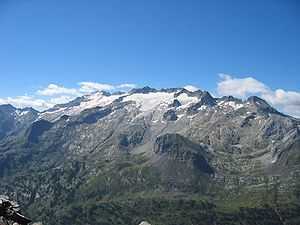

Spain, as the second most mountainous country of Europe, is full of high mountains and good ski resorts, with famous ski slopes all over Spain, including the Pyrenees, the Sistema Central, the Sistema Ibérico and Sierra Nevada. For the most part, the main crest forms a massive divider between France and Spain, with the tiny country of Andorra sandwiched in between. The Crown of Aragon and the Kingdom of Navarre have historically extended on both sides of the mountain range, with small northern portions now in France and much larger southern parts now in Spain.[15][16]
Sierra Nevada in Spain is a popular tourist destination, as its high peaks make skiing possible in one of Europe's most southerly ski resorts, in an area along the Mediterranean Sea predominantly known for its warm temperatures and abundant sunshine. At its foothills is found the city of Granada and, a little further, Almería and Málaga.
Parts of the range have been included in the Sierra Nevada National Park. The range has also been declared a biosphere reserve. The Sierra Nevada Observatory is located on the northern slopes at an elevation of 2,800 metres (9,200 ft). The Sierra Nevada was formed during the Alpine Orogeny, a mountain-building event that also formed the European Alps to the east and the Atlas Mountains of northern Africa across the Mediterranean Sea to the south. The Sierra as observed today formed during the Paleogene and Neogene Periods (66 to 1.8 million years ago) from the collision of the African and Eurasian continental plates.
Nature and rural tourism

Spain is the third largest country in Europe, and has a diverse landscape and, as a result, is often called “a miniature continent”. Spain is the most mountainous country in Europe after Switzerland, despite the fact that a 45% of its Mainland area is occupied by the Meseta Central ("Inner Plateau"), the high plains of central Spain. The rest of the country is dominated by several Mountain ranges, including peaks that exceed 3,000 meters; significant lowlands and a vast coast, alternating rugged cliffs with sandy beaches, bays, capes and coves. Spain also has two archipelagos with a variety of landscapes, the Balearic Islands with a typical Mediterranean landscape and the diverse Canary Islands.
Many indigenous and endemic species owe their current situation to the existence of protected areas with which they try to avoid their decline or extinction. To date, Spain has a total of 15 National Parks, of which 10 are on the mainland, 1 in the Balearic Islands and 4 in the Canary Islands. Spain's most visited National Park is the Teide National Park in the Canary Islands, with 3,142,148 visitors in 2007 and crowned with the third largest Volcano in the world from its base, the Teide, with 3,718 meters above the sea level (also the highest point in Spain). The Teide also has the distinction of being the most visited national park in Europe and second in the world.[17]
Art and culture, Museums in Madrid
Madrid is considered one of the top European destinations concerning art museums. Best known is the Golden Triangle of Art, located along the Paseo del Prado and comprising three museums. The most famous one is the Prado Museum, known for such highlights as Diego Velázquez's Las Meninas and Francisco de Goya's La maja vestida and La maja desnuda. The other two museums are the Thyssen Bornemisza Museum, established from a mixed private collection, and the Reina Sofia Museum, where Pablo Picasso's Guernica hangs, returning to Spain from New York after more than two decades.
The Museo del Prado is a museum and art gallery that features one of the world's finest collections of European art, from the 12th century to the early 19th century, based on the former Spanish Royal Collection. The collection currently comprises around 7,600 paintings, 1,000 sculptures, 4,800 prints and 8,200 drawings, in addition to a large number of works of art and historic documents. El Prado is one of the most visited museums in the world, and it is considered to be among the greatest museums of art. It has the best collection of artworks by Goya, Velázquez, El Greco, Rubens, Titian, Hieronymus Bosch, José de Ribera and Patinir; and works by Rogier van der Weyden, Raphael Sanzio, Tintoretto, Veronese, Caravaggio, Van Dyck, Albrecht Dürer, Claude Lorrain, Murillo and Zurbarán, among others.
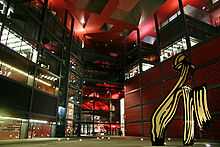
The Museo Nacional Centro de Arte Reina Sofía (MNCARS) is the Spain's national museum of 20th-century art. The museum is mainly dedicated to Spanish art. Highlights of the museum include excellent collections of Spain's greatest 20th-century masters, Pablo Picasso, Salvador Dalí, Joan Miró, Juan Gris and Julio González. Certainly the most famous masterpiece in the museum is Picasso's painting Guernica. The Reina Sofía also hosts a free-access library specializing in art, with a collection of over 100,000 books, over 3,500 sound recordings and almost 1,000 videos.[18]
The Thyssen-Bornemisza Museum is an art museum that fills the historical gaps in its counterparts' collections: in the Prado's case this includes Italian primitives and works from the English, Dutch and German schools, while in the case of the Reina Sofia the Thyssen-Bornemisza collection, once the second largest private collection in the world after the British Royal Collection,[19] includes Impressionists, Expressionists, and European and American paintings from the second half of the 20th century, with over 1,600 paintings.[20]
The Royal Academy of Fine Arts of San Fernando currently functions as a museum and gallery that houses a fine art collection of paintings from the 15th to 20th centuries: Giovanni Bellini, Correggio, Rubens, Zurbarán, Murillo, Goya, Juan Gris, Pablo Serrano. The academy is also the headquarters of the Madrid Academy of Art. Francisco Goya was once one of the academy's directors, and, its alumni include Pablo Picasso, Salvador Dalí, Antonio López García, Juan Luna, and Fernando Botero.[21][22]
The Royal Palace of Madrid is the official residence of Juan Carlos I of Spain, but he uses it only for official acts. It is a baroque palace full of artworks is one of the largest European Royal Palaces, which is characterized by its luxurious rooms and its rich collections of armors and weapons, pharmaceutical, silverware, watches, paintings, tapestries and the most comprehensive collection of Stradivarius in the world[23]
The National Archaeological Museum of Spain collection includes, among others, Pre-historic, Celtic, Iberian, Greek and Roman antiquities and medieval (Visigothic, Muslim and Christian) objects. Highlights include a replica of the Altamira cave (the first cave in which prehistoric cave paintings were discovered), Lady of Elx (an enigmatic polychrome stone bust), Lady of Baza (a famous example of Iberian sculpture), Biche of Balazote (an Iberian sculpture) and Treasure of Guarrazar (a treasure that represents the best surviving group of Early Medieval Christian votive offerings and the high point of Visigothic goldsmith's work).[24]
The Museum of the Americas (Spanish: Museo de América) is a National museum that holds artistic, archaeological and ethnographic collections from the whole American continent, ranging from the Paleolithic period to the present day. The permanent exhibit is divided into five major thematical areas: an awareness of America, the reality of America, society, religion and communication.[25]
The National Museum of Natural Sciences is the National Museum of Natural History of Spain. The research departments of the museum are: Biodiversity and Evolutionary Biology, Evolutionary Ecology, Paleobiology, Vulcanology and Geology.[26]
The Naval Museum is managed by the Ministry of Defence. The Museum's mission is to acquire, preserve, investigate, report and display for study, education and contemplation, parts, sets and collections of historical, artistic, scientific and technical related to naval activity in order to disseminate the story sea of Spain; to help illustrate, highlight and preserve their traditions and promote national maritime awareness.
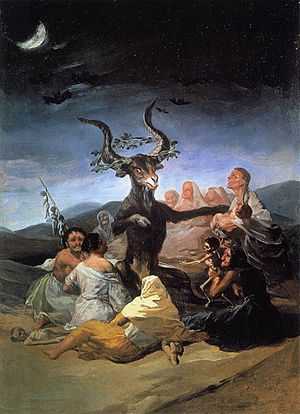
The Monastery of Las Descalzas Reales resides in the former palace of King Charles I of Spain and Isabel of Portugal. Their daughter, Joan of Austria, founded this convent of nuns of the Poor Clare order in 1559. Throughout the remainder of the 16th century and into the 17th century, the convent attracted young widowed or spinster noblewomen. Each woman brought with her a dowry. The riches quickly piled up, and the convent became one of the richest convents in all of Europe. It has many works of Renaissance and Baroque art, including a recumbent Christ by Gaspar Becerra, a staircase whose paintings were painted by unknown author (perhaps Velázquez) and they are considered of the masterpieces of Spanish illusionist painting, and Brussels tapestries inspired by paintings of Rubens.[27]
The Museum of Lázaro Galdiano houses an encyclopedic collection specializing in decorative arts.
Apart from paintings and sculptures it displays 10th-century Byzantine enamel; Arab and Byzantine ivory chests; Hellenistic, Roman, medieval, renaissance, baroque and romantic jewelry; Pisanello and Pompeo Leoni medals; Spanish and Italian ceramics; Italian and Arab clothes and a collection of weapons including the sword of Pope Innocent VIII.[28]
The Museo Nacional de Artes Decorativas (National Museum of Decorative Arts) is one of the oldest museums in the city. It illustrates the evolution of the called "minor arts" (furniture, ceramics and glass, textile, etc.). Its 60 rooms expones 15,000 objects, of the approximate 40,000 which it has.[29]
The Museo Nacional del Romanticismo (National Museum of Romanticism) contains a large collection of artefacts and art, focusing on daily life and customs of the 19th century, with special attention to the aesthetics about Romanticism.[30]
The Museo Cerralbo houses a private collection of ancient works of art, artifacts and other antiquities collected by Enrique de Aguilera y Gamboa, XVII Cerralbo Marquis.[31]
The Museo Nacional de Antropología(National Museum of Anthropology) provides an overview of the different cultures in the world, with objects and human remains from around the world, highlighting a Guanche mummy of the island of Tenerife.[32]
The Museo Sorolla is located in the building in which the Valencian Impressionist painter had his home and workshop. The collection includes, in addition to numerous works of Joaquín Sorolla, a large number of objects that possessed the artist, including sculptures by Auguste Rodin.[33]

CaixaForum Madrid is a post-modern art gallery in the centre of Madrid. It is sponsored by the Catalan-Balearic bank la Caixa and located next to the Salón del Prado. Although the CaixaForum is a modern building, it also exhibits retrospectives of artists from earlier time periods and has evolved into one of the most visited museums in Madrid. It was constructed by the Swiss architects Herzog & de Meuron from 2001 to 2007, which combined an old unused industrial building and hollowed it out at the base and inside and placed on top further floors which are encased with rusted steel. Next to it is an art installation of green plants growing on the wall of the neighbouring house by French botanist Patrick Blanc. The red of the top floors with the green of the wall next to it form a contrast. The green is in reflection of the neighbouring Royal Botanical Gardens.
Other art galleries and museums in Madrid include:
- Royal Palace of Madrid[34]
- Royal Academy of Fine Arts of San Fernando[21][22]
- National Archaeological Museum of Spain[24]
- Museum of the Americas[25]
- National Museum of Natural Sciences[26]
- Liria Palace
- Naval Museum[35]
- Spanish Air Force Museum[36]
- Monastery of Las Descalzas Reales[27]
- Museum of Lázaro Galdiano[28]
- Royal Palace of El Pardo[37]
- Railway Museum[38]
- Museum Sorolla[33]
- CaixaForum Madrid[39]
Art and culture, Museums in Barcelona
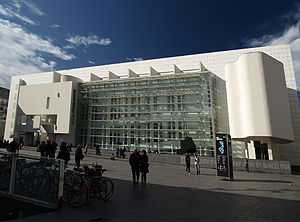

This is a list of museums in Barcelona (Catalonia) and in its surrounding metropolitan area.
- Archaeology Museum of Barcelona (MAC)
- Museu d'Art Contemporani de Barcelona (MACBA)
- Museu del Modernisme Català (MMCAT)
- CaixaForum Barcelona
- Casa Àsia
- Centre d'Art Santa Mònica (CASM)
- Centre de Cultura Contemporània de Barcelona (CCCB)
- Cosmocaixa Barcelona (former Museu de la Ciència de Barcelona)
- Espai Gaudí (La Pedrera)
- Fundació Antoni Tàpies
- Olympic and Sports Museum Joan Antoni Samaranch
- Fundació Joan Miró
- Fundació Suñol
- FC Barcelona Museum
- Gracia Arts Project
- Institut Botànic de Barcelona
- Jardí Botànic de Barcelona
- Palau Reial de Pedralbes
- Museu de Ceràmica
- Museu de les Arts Decoratives
- Museu Tèxtil i d'Indumentària
- Museu d'Autòmates
- Museu Barbier-Mueller d'Art Precolombí
- Museu del Calçat
- Museu de Cera de Barcelona
- Museu de Ciències de Barcelona
- Museu del Clavegueram
- Museu del Còmic i la Il·lustració
- Museu Egipci de Barcelona
- Museu de l'Eròtica de Barcelona
- Museu Etnològic de Barcelona
- Museu Frederic Marès
- Museu Gaudí
- Museu de Geologia
- Museu d'Història de Catalunya
- Museu d'Història de la Ciutat
- Centre d'Interpretació del Park Güell
- Museu Marítim
- Museu Militar de Barcelona (closed May 2009)
- Museu de la Música de Barcelona
- National Art Museum of Catalonia (MNAC)
- Museu del Perfum - Fundació Planas Giralt
- Museu Picasso
- Museu Taurí
- Museu de la Xocolata
- Museu de Zoologia
- Palau de la Virreina
- Palau Robert
- Sala Ciutat
- Sagrada Familia
References
- ↑ "China world's third most visited country: UN". Retrieved 26 January 2011.
- ↑ World Tourism and Travel Council
- ↑ World Travel and Tourism Council
- ↑ UNWTO
- ↑ Página Web Oficial de Turismo de Tenerife; El Teide, el Parque Nacional más visitado de España
- ↑ El Parque Nacional del Teide
- ↑
- ↑ SPANISH TOURIST OFFICE NEWS UPDATE – NOVEMBER 2012
- ↑ 9.0 9.1
- ↑
- ↑ "Spain – Properties inscribed on the World Heritage List". UNESCO. Retrieved 17 September 2010.
- ↑ Villas in Spain | Villa Spain
- ↑ Armstrong, Stephen (2006-07-01). "Ibiza unplugged". London: The Guardian. Retrieved 4 May 2010.
- ↑ Keenan, Steve (July 6, 2009). "Mallorca v Majorca which is correct". The Times (London).
- ↑ Preamble of the "Charter of the Catalan Language"
- ↑ Collins Road Atlas of Europe. London: Harper Collins. 1995. pp. 28–29. ISBN 0-00-448148-8.
- ↑ "El parque nacional del Teide es el primero más visitado de Europa y el segundo del mundo" (in Spanish). Retrieved 30 September 2013.
- ↑ "Museo Reina Sofía (MNCARS), official english webpage". Museoreinasofia.es. Retrieved 3 January 2013.
- ↑ Kandell, Jonathan (28 April 2002). "Baron Thyssen-Bornemisza, Industrialist Who Built Fabled Art Collection, Dies at 81". The New York Times. Retrieved 7 August 2012.
- ↑ "Thyssen-Bornemisza Museum, official english webpage".
- ↑ 21.0 21.1 "The Real Academia de Bellas Artes de San Fernando Museum, Madrid". Gomadrid.com. Retrieved 30 September 2013.
- ↑ 22.0 22.1
- ↑ .http://www.patrimonionacional.es/Home/Palacios-Reales/Palacio-Real-de-Madrid.aspx
- ↑ 24.0 24.1 Ignacio Sánchez Ramírez – info @ visionados. com. "Museo Arqueológico Nacional | Inicio". Man.mcu.es. Retrieved 1 June 2011.
- ↑ 25.0 25.1 "Museo de América". Museodeamerica.mcu.es. Retrieved 1 June 2011.
- ↑ 26.0 26.1 "Portada". MNCN. 27 May 2011. Retrieved 2 June 2011.
- ↑ 27.0 27.1 "Patrimonio Nacional – Monasterio de las Descalzas Reales". Patrimonionacional.es. Retrieved 14 April 2011.
- ↑ 28.0 28.1 "Fundación Lázaro Galdiano museum website". Flg.es. Retrieved 14 April 2011.
- ↑ "Museo de Artes Decorativas". Mnartesdecorativas.mcu.es. Retrieved 1 June 2011.
- ↑ "Museo del Romanticismo". Museoromanticismo.mcu.es. Retrieved 1 June 2011.
- ↑ "Museo Cerralbo". Museo Cerralbo. Retrieved 1 June 2011.
- ↑ "Museo Nacional de Antropología". Mnantropologia.mcu.es. Retrieved 1 June 2011.
- ↑ 33.0 33.1 "Museo Sorolla". Museo Sorolla. Retrieved 1 June 2011.
- ↑ "Patrimonio Nacional - Palacio Real de Madrid". Patrimonionacional.es. Retrieved 3 January 2013.
- ↑ "INICIO MUSEO NAVAL MADRID - Museo Naval - Armada Española - Ministerio de Defensa - Gobierno de España" (in Spanish). Armada.mde.es. Retrieved 3 January 2013.
- ↑ "de Madrid" (in Spanish). Museo del Aire. Retrieved 3 January 2013.
- ↑ "Patrimonio Nacional - Real Sitio de El Pardo". Patrimonionacional.es. Retrieved 3 January 2013.
- ↑ "Museo del Ferrocarril de Madrid Delicias - Fundación de los Ferrrocarriles Españoles". Museodelferrocarril.org. Retrieved 3 January 2013.
- ↑ "Caixaforum Madrid | Nuestros centros | Obra Social "la Caixa"". Obrasocial.lacaixa.es. 1974-01-15. Retrieved 3 January 2013.
External links
| Wikivoyage has a travel guide for Spain. |
- Spanish Tourism Official Website in English
-
 Media related to Tourism in Spain at Wikimedia Commons
Media related to Tourism in Spain at Wikimedia Commons - Spain Travel
- English News Magazine Spain
- The regions of Spain, a brief introduction and guide.
- Turismo Cultural & City Break Trade Fare
| ||||||||||||||||||||||||||||||||||||||||||||||||
| ||||||||||||||



_04.jpg)

_01.jpg)
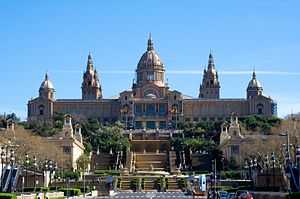
.jpg)
